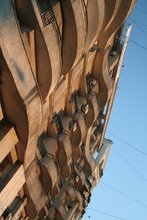As I waited for my friend to finish his meeting yesterday, I hid from the wind and snow in the Palace of Culture in Târgu Mures, and had a look at the History Museum there. History here is reduced to an archaeological collection of ceramics and iron-made ‘tools’ that more often than not are very silent about possible uses in daily life. I got very frustrated by the glass boxes as I attempted to reconstruct some kind of social life around these objects in my imagination. The collection is concentrated mainly on the glorious distant past, and the places of discovery are indicated on light-faded maps. This is definitely something Umberto Eco should have included among his brilliant excursions on ‘How to organise a public library’ and the like. I did a bit of collecting myself and present to you here the most interesting ‘explanatory comments’, presented on laminated beige posters in a very poetic English voice, as you will discover. How to make a museum as dusty as possible:
The Starcevo-Cris culture is representative for the beginning of the Neolithic. This culture is characteristic through the painted ceramics tools made by cut and polish rocks. The smalls settlements is formed by cottage.
(…)
The funerary habit was represented by incineration in plane or tumular graves.
(…)
The economy was mixted.
(…)
The tibula was used as a dress decoration. For the first time appeared in the Bronze Age and it was used until the Great Migrations (7th Century)
(…)
The 2nd Iron Age.
The ferrous metallurgy would reach its climax in La Tène due to the Celts and progressively generalise, to a large extent beginning with the 2nd Century B.C. The Dacian iron civilisation is undoubtedly one of the most remarkably civilisations of the ‘barbarian’ Europe.
(…)
The Roman epoch (106-271 A.D.) signified the moment of outmost interaction with the universal history, as the history of the Roman province of Dacia is part of the history of the Roman Empire. Accomplishing the role of a strategic bastion positioned in the barbaric world, Dacia had the statute of imperial province.
(…)
I especially like the Polish rocks, and I want a plane grave too, please! Also amazed at the (very ambivalent) emphasis on how proto-Romania was already more European / civilised than its barbaric neighbours, something reproduced in the nationalist discourse of the nineteenth century, and in the Romanisation efforts of the language at that time. This is most likely largely an issue of historiography, and of the timing at which these posters were put up. I suspect just after the revolution… but maybe someone has a more definite idea on this? Very revealing also considering the large Hungarian population of this town, and the bloody confrontations in 1990 on the Piata Trandafirilor between Hungarian students and peasants sent in from the countryside by Romanian group Vatra. Finally, what on earth are laypersons like me supposed to think about the generalised climax of ferrous metallurgy? Sound and fury… signifying and teaching nothing.








No comments:
Post a Comment